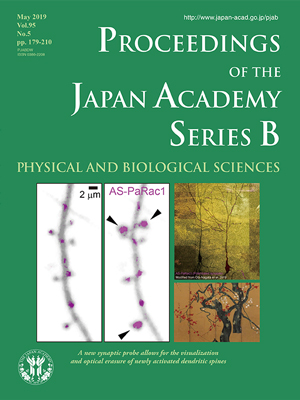About the Cover
Vol. 95 No. 5 (2019)
The adult human brain consists of approximately a hundred billion neurons, which are connected via synapses. The pattern and strength of synaptic connections are constantly changing (synaptic plasticity), and these changes are considered to underlie learning, memory, and personality. Many psychiatric disorders have been related to disturbances in synaptogenesis and subsequent plasticity. However, the links between spines and brain function have been largely correlational because of a lack of techniques for manipulating individual spines. Seeking out where and when synapses are generated and potentiated in the living brain is a key achievement in recent work by Hayashi-Takagi and colleagues (Featured in this issue as Obi-Nagata et al., pp. 179-197). They developed a novel synaptic optoprobe, Activated Synapse targeting PhotoActivatable Rac1 (AS-PaRac1), which is unique not only because it can specifically label recently potentiated spines, but it can also selectively induce shrinkage in just those spines containing AS-PaRac1. Using in vivo two-photon imaging of AS-PaRac1, synaptic potentiation was visualized during active remodeling of the neocortex. Until this method was developed, clear visualization of spine structures in vivo required sparse labelling of neurons, and analyses of spine structural changes required longitudinal within-subject imaging, which is laborious. In contrast, AS-PaRac1 is visualized as a fluorescence punctum (Arrowhead), as if it was a red plum tree coming into blossom in a gilded folding screen (Asian traditional craft). Thus, this method enables researchers to identify the potentiated spine far more easily with any transfection conditions. Upon learning a motor skill, AS-PaRac1 expression was induced in a relatively small number of neurons, in which approximately 8% of spines exhibited AS-PaRac1 broadly distributed throughout the dendritic tree. The blue light-induced shrinkage of learning-related spines disrupted the acquired motor learning, providing a glimpse of the complexity of neuronal structural changes responsible for task-specific learning. This finding raises further questions: How are these neurons linked in circuits? How equivalent are the contributions of individual spines to higher brain function? Ultimately, it will also be interesting to learn how this dysfunction of structural change might be involved in psychiatric disorders. This novel light-dependent tool for "Synaptic optogenetics" can open up new areas of synaptic research, and by extension, shed light on the neural networks that determine who we are.
Masanori Murayama
Team Leader
RIKEN Center for Brain Science




